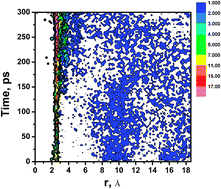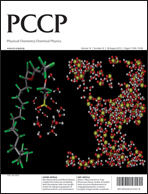ReaxFF molecular dynamics simulation of thermal stability of a Cu3(BTC)2 metal–organic framework†
Abstract
The thermal stability of a dehydrated Cu3(BTC)2 (copper(II) benzene 1,3,5-tricarboxylate) metal–organic framework was studied by molecular dynamics simulation with a ReaxFF reactive force field. The results show that Cu3(BTC)2 is thermally stable up to 565 K. When the temperature increases between 600 K and 700 K, the framework starts to partially collapse. The RDF analysis shows that the long range correlations between Cu dimers disappear, indicating the loss of the main channels of Cu3(BTC)2. When the temperature is above 800 K, we find the decomposition of the Cu3(BTC)2 framework. CO is the major product, and we also observe the release of CO2, O2, 1,3,5-benzenetricarboxylate (C6H3(CO2)3, BTC) and glassy carbon. The Cu dimer is stable up to 1100 K, but we find the formation of new copper oxide clusters at 1100 K. These results are consistent with experimental findings, and provide valuable information for future theoretical investigations of Cu3(BTC)2 and its application in


 Please wait while we load your content...
Please wait while we load your content...